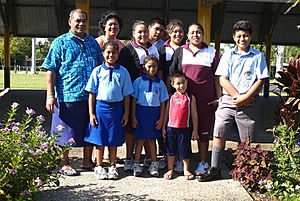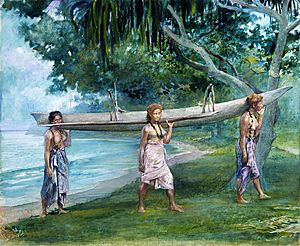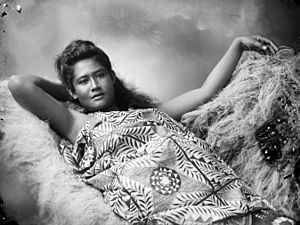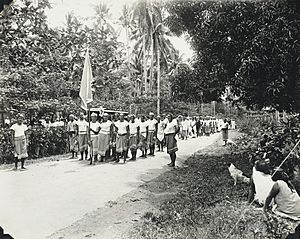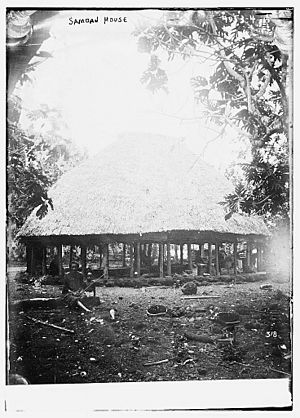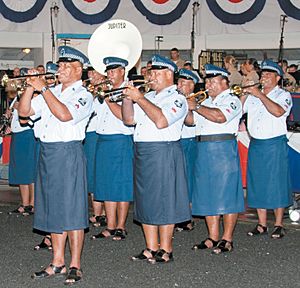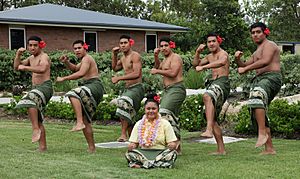Samoans facts for kids

Samoan canoe performers
|
|
| Total population | |
|---|---|
| c. 650,000-700,000 | |
| Regions with significant populations | |
| 204,600 | |
| c. 202,506 | |
| 182,721 | |
| 75,755 | |
| c. 50,000 | |
| 1,100 | |
| Languages | |
| Samoan, English | |
| Religion | |
| Christianity, traditional faith | |
| Related ethnic groups | |
| Other Polynesians | |
The Samoan people (Samoan: tagata Sāmoa) are the native Polynesians who live on the Samoan Islands. These islands are part of Polynesia. Samoans speak the Samoan language. The Samoan Islands are split into two main parts: the independent country of Samoa and American Samoa, which is a territory of the United States. Even though they are in different countries, the people share the same culture and language.
Samoan people and their culture were very important in shaping and spreading Polynesian culture, language, and religion across Eastern Polynesia. Trade, religion, wars, and colonization in Polynesia likely started with Samoan culture. Samoa's history, along with Tonga, Fiji, and French Polynesia, helped create modern Polynesian culture.
Contents
Samoan Society and Leaders
Samoan society has different groups of people. Three important groups are the matai (chiefs), the aiga (family leaders), and the aumaga (workers). The aumaga are supervised by a manaia.
The Matai: Family Leaders
A matai is the head of a family, including the extended family. This is a very important role in Samoan culture. To understand the matai, we need to know how they are chosen and what they do.
What a Matai Does
The matai has a big and important job. They lead the family in all parts of life. They help keep family relations strong and offer advice. They also guide religious activities and settle arguments. A matai looks after the family land and speaks for the family in village matters.
A matai must act differently from others, especially other men in the family. They also manage money and resources. For example, a matai makes sure the family has enough food. They also store food for hard times. The matai's leadership is key to the structure of Samoan culture.
How a Matai is Chosen
Choosing a matai is a long process. It can take several weeks and is often very competitive. Different parts of a family suggest a male candidate. They explain why he would be a good leader. Reasons include wisdom, wealth, and skills in talking or managing things.
If a matai's son meets the requirements, he often has a better chance. Sons or men living in a matai's home also get an advantage. They can watch and help the matai from a young age. Most men considered for the matai role are at least 40 years old.
One way for a man to become a matai is to live in a household with no other men. Or, he might move to his wife's household if there are no men there.
Another matai from a related family guides the election to keep it fair. Once a new matai is chosen, the family has a feast. Later, there is a bigger feast for the whole village. At this larger feast, the matai gives a special speech. This speech shows his public speaking skills and wisdom. He also retells Samoan myths.
The village council and other matais watch him closely. After proving himself, he serves the whole community. The new matai must host a village-wide feast. He provides food and gifts for the other matais.
Once these tasks are done, he is officially the matai of his household. He holds this position for life, if he leads well. Sometimes, a matai might be seen as unfair or ineffective. In these cases, his title can be taken away, and a new matai is chosen. More often, an older or sick matai asks for a new one to be elected. This ensures strong leadership continues.
The Aiga: Household Heads
The main leader of each household is called the aiga. Usually, a male is chosen to be the aiga of his extended family.
Choosing an Aiga
An aiga is chosen after the previous one dies or can no longer do their duties. This can be due to old age or other reasons. Elections can be a long and difficult process for family members. One part of the family competes against another, which can cause tension.
What an Aiga Does
Each aiga owns their extended family's land. Families live on this land, grow crops, cook, and do other chores. The matai also lives on this land.
Many aiga exist within a single village. Some families can trace their aiga history back many generations. This is because the title can be claimed through blood ties, marriage, or adoption.
The Aumaga and Their Manaia
While chiefs and matais have titles, some men in the village do not. These men are part of a group called the aumaga.
These men do most of the hard work in the community. The aumaga build houses and fix roads. They also plant and harvest gardens, fish, and prepare coconut meat. The aumaga also have special duties for ceremonies. They help the chief with cooking for rituals and serving food at events.
They also help keep peace among themselves. They often play cards, cricket, or gather for dances and parties.
A relative of the chief, called the manaia (supervisor), leads the aumaga. The manaia helps organize their activities. Even if the manaia is not truly the chief's son, the matai still calls him "son."
Samoan History and Migration
Samoans (Tagata Māo‘i) have long believed they are the original people of their islands. They believe Samoans were created from a tear in the heavens. However, experts think that people from Southeast Asia arrived in the Samoan Islands about 3,500 years ago. These migrants then settled further east in what is now known as Polynesia.
It is possible that the Samoan Islands were settled before 1000 BC. This would mean the first settlements were there before people who used certain pottery arrived. Many Samoans also believe their islands were the starting point for the great voyages. These voyages led to the Polynesian expansion to the East and South.
These stories are written down by European historians and experts. Samoan high chiefs still tell these stories today during special ceremonies.
Ancient Samoan chiefs' speeches often mention past contacts with other Polynesian islands. These stories are called 'taeao'. They include tales of family and clan connections with nearby islands like:
- Tokelau (New Zealand)
- Tuamotu (French Polynesia)
- Huahine (French Polynesia)
- Tahiti (French Polynesia)
- Ha'apai (Tonga)
- Vava'u (Tonga)
- Rarotonga (Cook Islands)
- Pukapuka (Cook Islands)
- Tuvalu
- Havai'i (Hawaii)
- Futuna (France)
- Uvea (France)
- Rotuma (Fiji)
- Viti Levu (Fiji)
Europeans first made contact with Samoans in the 18th century. Christianity was officially brought to the islands in August 1830 by missionaries.
In the early 1900s, Germany, Great Britain, and the USA colonized the Samoan Islands. The islands of Tutuila and Aunu'u were taken by the US. Later, the Kingdom of Manu'a joined them in 1904. Together, they became the territory of American Samoa. The western islands became German Samoa. In 1914, New Zealand took these islands from Germany. They renamed them Western Samoa. Western Samoa became independent on January 1, 1962. In 1997, it officially changed its name to Samoa.
Family Life and Traditions
Marriage Ceremonies
Marriage ceremonies are important cultural events in Samoa. A marriage involves the exchange of property. The bride's family gives toga, and the groom's family gives oloa. It is a village-wide event with two ceremonies and a feast.
First, the bride and groom walk through the village to a judge. The judge performs a civil ceremony. After that, the newlyweds go to a church for a religious ceremony. A church member performs this part. At the feast, families from all over the village bring food.
After the wedding, the new couple chooses which side of the family they want to live with. Once they move in, they are expected to work on the land and in the house. This helps provide for their family.
When families have children, the children are also expected to help. By age three or four, they start with duties and chores. Young girls take care of other children and help with housework. Boys help with farming, animals, and getting water. By age seven or eight, children are expected to know and be used to Samoan life and chores. This includes being good at "agriculture, fishing, cooking, and child care." As Samoans grow up, they get more tasks and responsibilities. They continue until they can fully take over for older family members.
Funerals and Respect
When a family member dies, funeral preparations start almost right away. Choirs go to the mourner's home. The body of the person who died is washed and dressed in white. They are placed on woven mats before the funeral, which happens less than 24 hours later. During those 24 hours, at least one family member stays with the deceased.
A feast ends the event. Food is served to mourners and those who helped with the burial. Other family members take on the duties of the person who died. They also continue their own chores around the home.
Land Ownership and Use
The elected Matai of the community controls all parts of village land. The village Matai decides what farmers will do with the land. They also "control who gets plots and how those plots are used." The only thing the Matai does not control is who gets the land after he dies. This stops one family from controlling it for too long. Land is divided into four types: Village House Lots, Underbrush, Family Reserve, and Village Land.
Village House Lots
Village house lots are where individual houses or huts are built. These houses are built close together. Each house includes a main sleeping house, a guest house, and a latrine. Yards with trees and gardens make up the house village lot. Some lots hold the entire extended family.
Underbrush Areas
The underbrush covers all the land. These land plots are known to all villagers. They are separated by boundaries. Boundaries are usually made of rocks, streams, trees, and plants. It is easy to tell the different properties owned by separate families.
Family Reserve Lands
Family reserve sections are where crops are grown. The most common crops grown in Samoan culture are taro leaves and yams. These plots can be shared with other villages and families. However, if shared, they are no longer called a family reserve. The family would own the crops, but not the land itself. The family reserve is not farmed as much as other land. This is because crops here grow quickly and easily without many problems.
Village Land for Community Use
Village land is the least farmed and most shared land in Samoan villages. To plant here, you need permission from the village council. This is because "the land is community property and not family owned." Village land is the largest type of land. It is where hunting for food, like wild pigs and birds, is allowed. Fishing is also allowed on village land.
Samoan Culture and Arts
Traditional Tattooing
Traditional Samoan tattoos, called tatau, show the strong connection many Samoans feel to their culture. Samoans have been tattooing men and women for over 2,000 years. Today, a man's tattoo, called a pe'a, covers his mid-back, sides, and goes down to his knees. A woman's tattoo, called a malu, is not as large or dark. The patterns are geometric and based on old designs. They often show a person's rank or status. For example, the va'a (canoe) design stretches across a man's mid-back.
In the past, most Samoan males were tattooed between ages 14 and 18. This was when they were thought to have stopped growing. This way, the designs would not stretch and lose their beauty. Today, traditional tattooing has become popular again. This is true not only in Samoa but across Polynesia. It is often a symbol of cultural identity.
Tatau, the Samoan word for tattoo, means "correct" or "rightness." It also refers to the correct square shapes in the designs. Samoan tattoo designs do not use circular lines, unlike some other Polynesian tattoos. Early Englishmen mispronounced tatau and used it as the word "tattoo."
Traditional tattooing is a painful process. The Samoan tattoo master dips his tools into black ink. This ink is made from the soot of burnt candlenut shells. Then, he punctures the designs into the skin. The cutting tool is a short piece of bamboo or light wood. It has a piece of tortoiseshell tied at a right angle at one end. A small bone comb is tied to the lower wide end of the tortoiseshell. The bigger the comb, the more skin is covered with fewer strokes. The master uses a small mallet to tap the tool repeatedly. The process takes days and can sometimes be done over longer periods, with breaks for healing.
Tattoo designs have changed to include freehand symbols. These include the kava bowl, which means hospitality. The Samoan house or fale means kinship. Nature symbols like shells, fish, birds, waves, and centipedes are also used. Traditional geometric lines and angles of different lengths and sizes are still common.
Samoan Music
Modern pop and rock music are popular in Samoa. Several local bands play these styles. These bands have mostly moved away from traditional Samoan music. However, some folk performers still exist. Recently, old Samoan songs have become popular again. They are often remixed with a reggae style but keep some traditional elements. These include the pate drum and old chord structures.
In early Samoan music, there were only two instruments. These were the pate, a hollowed-out log drum of different sizes, and the fala. The fala is a rolled-up mat beaten with sticks. The human voice was also very important. Even with few instruments, music was a big part of Samoan life. Many stories and legends were passed down through songs. The complex rhythms from the pate are essential for many Samoan dances. In some dances, the dancers clap their hands to add to the rhythm. They can make different sounds by holding their hands in different ways.
Two instruments were later developed that are now linked with Samoan music: the selo and the ukulele. The selo is a stringed instrument. It is made from a broomstick or similar object. This is attached to a large box or bucket that acts as a soundboard. A single string connects the top of the stick to the box. When plucked, it makes a sound like a bass guitar. The ukulele is a small, four-string guitar-like instrument. It comes in two forms. One looks like a tiny guitar. The other has a body made from half a coconut shell.
Western string instruments like guitars are common across the Pacific Islands. Many bands have been playing and recording music in Samoa since the 1970s. Younger generations still play in string bands. They also enjoy genres like reggae, hip hop, rhythm and blues, gospel, and soul.
Music is a huge part of Samoan culture. Traditional Samoan music still has a role today. However, it has partly changed due to modern or outside influences. Reggae and Hawaiian music have also greatly influenced Samoa. Many popular musicians are from Samoa or have Samoan roots. These include reggae artist J Boog and the hip hop group Boo-Yaa T.R.I.B.E. One of Samoa's most famous bands is The Five Stars. Opera singer Jonathan Lemalu won a Grammy Award for his work on "Britten: Billy Budd."
Samoa is known for a guitar style called “Le Igi.” This fingerpicking style comes from Hawaii, where it is called “Slack Key Guitar.” Another traditional Samoan instrument is the Fala. It is made of rolled "wicker-style mats" and beaten with drumsticks to make a drum sound. The Pate is another popular drum in Samoa. It came from Tahiti about 500 years ago. It is made of carved wood with tribal designs.
Samoan Dance
The Fire knife dance, or Siva Afi, is the most popular Samoan dance for tourists. The Fa'ataupati, or slap dance, is performed by males. It involves fiercely slapping the body in rhythm to drum beats. Other Samoan dances include the Maulu'ulu, an elegant dance performed by all females. The Sasa can be performed by both males and females. They can be seated or standing.
The Siva Tau is a war dance. Samoan sports teams perform it before each match. The Taualuga is a celebration dance. It is central to Samoan culture and has been changed in Western Polynesia. Traditionally, the virgin highborn son or daughter of a Samoan chief performed it. A taupou (female) or manaia (male) dresses in special festive clothes for the siva. This usually includes a finely woven ie'toga mat decorated with feathers from the "sega" bird. Today, dyed chicken feathers are often used.
Performers also wear many anklets and armbands. These are made of ti leaves, sea turtle shells (uga laumei), coconut shells, or boar's tusk. The taupou or manaia wears a special headdress called a "tuiga." Performers are also covered in coconut oil for a shiny look. During the dance, upbeat but simple drum beats accompany them. This dance is usually performed at various cultural celebrations.
Sports and Samoan Athletes
Athletes of Samoan descent are famous for their success in full-contact sports. These include American football, rugby union, rugby league, boxing, professional wrestling, and mixed martial arts.
Samoa is said to produce many top-level rugby union and rugby league players for its size. American Samoa produces the most NFL players. It has been called "Football Island" by coaches and media. It is believed that a boy born to Samoan parents is 56 times more likely to join the NFL than any other boy in America. Samoans also do well in sports with less contact or no contact. These include basketball, baseball, netball, soccer, and volleyball.
Notable Samoans
- List of Samoans



